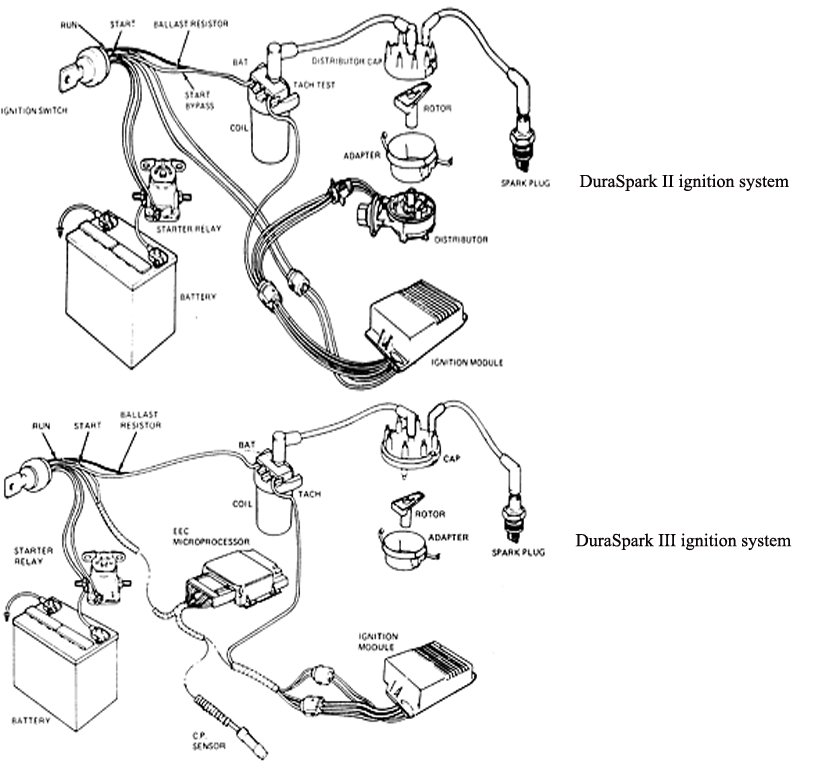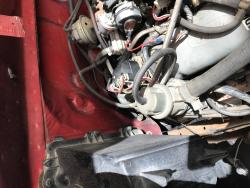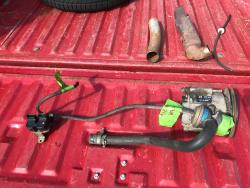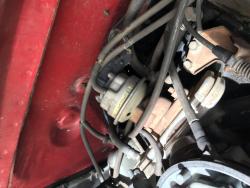1983 F150 5.8L 351W 4x4 Project
Re: 1983 F150 5.8L 351W 4x4 Project
|
Administrator
|
To that end buy a $50 HEI and a $100 carb. You can have reliable fuel and ignition in an afternoons work. Consider buying a used timing light for $10 on eBay.
Jim,
Lil'Red is a '87 F250 HD, 4.10's, 1356 4x4, Zf-5, 3G, PMGR, Saginaw PS, desmogged with a Holley 80508 and Performer intake. Too much other stuff to mention. |
|
This post was updated on .
In reply to this post by Tom
If you are going to keep your truck relatively stock but you want to get rid of the complicated variable-venturi carburetor, I think the simplest and most reliable solution for you would be to follow Ford's own engineering notes and replace it with a stock Motorcraft 2150 carburetor and a stock Duraspark II ignition system from a 1983 Ford F150 with a 5.8L 2V and a manual transmission. You would ideally want these specific items because there are MANY versions of the Motorcraft 2150 and the Duraspark II distributor with completely different calibrations.
When Ford was still selling vehicles with carburetors, they specifically calibrated their carburetors and distributors as a matched pair for each specific application. Ford took into account the engine family, engine size, vehicle size, weight, operating range, emissions equipment, and even transmission type and they calibrated their carburetors and distributors for each specific application. That is why no aftermarket carburetor will ever run as well as a stock one on a stock vehicle, and why you are almost always better off rebuilding your stock carburetor instead of replacing it with a store rebuild that may or may not match your specific calibration. The thing is, there are many different stock Motorcraft 2150 carburetors, and they all look largely the same from the outside. On the inside however, the boosters, jets, power valves, and even flow characteristics can be completely different. And on the distributors, the weights, timing, and advance curves can be completely different. If you get components that are not calibrated for your specific vehicle, you are going to hate your truck and end up being one of those people who are convinced that carburetors "suck" and they need to spend $1000 on an aftermarket fuel injection system. But if you get components with the correct calibrations, with just minor tuning your truck can run with the best of them! So where can you find these items? For the carburetor, I would purchase a Motorcraft 2150 from RockAuto. They sell Autoline rebuilds, which are pretty good because they use original Ford carburetors with the correct calibrations for the specific vehicle. The Motorcraft 2150 (and older Autolite 2100) is the best 2-barrel carburetor ever made. The choke system is better than anything aftermarket and the annular discharge boosters atomize fuel almost as good as fuel injection. I took the liberty of finding one for your truck: https://www.rockauto.com/en/catalog/ford,1983,f-150,5.8l+351cid+v8,1121375,fuel+&+air,carburetor,5904 Autoline C8178 is a remanufactured Motorcraft 2150 specifically calibrated to work on a stock 1983 Ford F150 with a 5.8L 2V engine with a manual transmission and *without* EEC-III. As such, it should run great on your truck with very little, if any, tuning. That leaves the distributor. Again, I took the liberty of finding one for your truck: https://www.rockauto.com/en/catalog/ford,1983,f-150,5.8l+351cid+v8,1121375,ignition,distributor,7108 Autoline D4046 is a remanufactured Duraspark II distributor specifically calibrated to work on a stock 1983 Ford F150 with a 5.8L 2V engine with a manual transmission and *without* EEC-III. As such, it should run great on your truck with very little, if any, adjustments. You will need a Duraspark II module to work with the Duraspark II distributor, but I am pretty sure the ignition coils are the same. OEM Ford Motorcraft parts always work the best and are the most reliable. You do not need a "high performance" ignition system for your truck. Ignition module, Motorcraft DY893: https://www.rockauto.com/en/catalog/ford,1983,f-150,5.8l+351cid+v8,1121375,ignition,ignition+control+module+(icm),7172 I don't know much about the Duraspark III system, so I don't know for sure if the ignition wire harness will work with the Duraspark II components or not, but I think it will with a few small modifications. If it doesn't, the junkyard is your only source for a Ford harness with all the correct connectors, but it will be a very simple "plug and play" affair with no wire cutting or splicing on your part. All you would need to do is unplug your existing EEC-III wire harness from your truck and plug the Duraspark II wire harness in its place. You will need one from a 1980 - 1986 Ford F-Series truck or Bronco with a 5.8L engine. If you have a factory tachometer, you need to make sure the harness you get also came from a truck with a tachometer. These used to be plentiful in junkyards, but with the newest one now being 35 years old, they are getting harder to find.  I think you can buy an aftermarket Duraspark II wire harness, but it will need to be modified to work on your truck. They are designed for older vehicles to replace points style ignition systems and are a bit different than the stock Ford Duraspark II wire harnesses. I hope this helps.
Lucille: 1985 Ford F150 XLT Lariat
*Colors: Dark Canyon Red exterior, Canyon Red interior *Engine: 5.0, CompCams 31-230-3, "Thumper" E7 heads, Edelbrock Performer intake, Autolite 4100 carburetor, DuraSpark II ignition, Thorley Tri-Y headers, Flowmaster dual exhaust, H-pipe. *Drivetrain: AOD transmission, 3.55 gears, 2wd. |
Re: 1983 F150 5.8L 351W 4x4 Project
|
Administrator
|
I'm using the Blue Streak FD476 (NOT "T") ignition coil.
I also had to edit my post about carburetor size. It auto corrected 1.14" in to 1 1/4" (which is obviously not a venturi size) But, like I said do what you want. Buy a $275 MSD 6AL if you think you want it. (and the Blaster II coil to go with it) Buy all Motorcraft components if you want, too. I can only speak about what works for me, in my situation... Which is generally broke and needing my truck to get my sorry butt to work, no matter what.
Jim,
Lil'Red is a '87 F250 HD, 4.10's, 1356 4x4, Zf-5, 3G, PMGR, Saginaw PS, desmogged with a Holley 80508 and Performer intake. Too much other stuff to mention. |
Re: 1983 F150 5.8L 351W 4x4 Project
|
Administrator
|
Tom, I've asked Bill to weigh in with carburetor advice...
Jim,
Lil'Red is a '87 F250 HD, 4.10's, 1356 4x4, Zf-5, 3G, PMGR, Saginaw PS, desmogged with a Holley 80508 and Performer intake. Too much other stuff to mention. |
Re: 1983 F150 5.8L 351W 4x4 Project
|
Administrator
|
I thought I had replied to this thread, it was regarding a 1983 351W with EEC-III and a 7200VV carburetor. The discussion was regarding the needed venturii size which is cast on the left side of the float bowl. 1.14 is the most common being for the 302 engines, I believe 1.21 was the 351, 352 and even 390 may have used that size. If by chance someone runs across a 1.33 marked bowl, that was for the 429 2V engine. Electric choke was also asked, if the engine has a choke stove on the intake then a hot air choke can be used, if not then an electric one will be needed.
A 1.21, particularly if the catalytic converter is gone should be great. EGR was also asked about and what I said was the EGR does help with light throttle detonation as it slows the burn rate slightly. Vacuum ports, some of the 2150 carbs had two, one coming in earlier than the other, the early one being used for vacuum advance and the later one for EGR, however, some Ford applications used the EGR port for both. EGR generally had a thermal vacuum valve to keep it from working until the engine was warm. Distributor and ignition system. First, since Ford built these trucks with numerous engine/emission packages, the front harness down the left inner fender probably has the connections for the DS-II system replacing the DS-III box, but you will need the distributor to coil and box wiring which may also have the oil pressure and temperature wiring in the same harness. You need the round can DS-II coil as it uses a resistance wire in the harness (should be there and the DS-III coil may be the same). One item, some DS-III systems used a crank pickup which if it is on the front outside of the engine can be removed, if it is on the rear, you will need to leave it there as it is in front of the rear crank seal and will spray oil if removed.
Bill AKA "LOBO" Profile
"Getting old is inevitable, growing up is optional" Darth Vader 1986 F350 460 converted to MAF/SEFI, E4OD 12X3 1/2 rear brakes, traction loc 3:55 gear, 160 amp 3G alternator Wife's 2011 Flex Limited Daily Driver 2009 Flex Limited with factory tow package Project car 1986 Chrysler LeBaron convertible 2.2L Turbo II, modified A413 |
Re: 1983 F150 5.8L 351W 4x4 Project
|
Administrator
|
Thanks for all this valuable information Bill.
I really appreciate that you are here to offer advice and share your decades of knowledge and experience. So, 1.21" it is. An electric choke (with assist, if it's there) seems the best for Vermont winters. Unless you learn your manual choke well and want it as an anti-theft device.  With that, Tom should have a reliable truck without the foibles of the present computer and its sensors.
Jim,
Lil'Red is a '87 F250 HD, 4.10's, 1356 4x4, Zf-5, 3G, PMGR, Saginaw PS, desmogged with a Holley 80508 and Performer intake. Too much other stuff to mention. |
|
In reply to this post by LARIAT 85
Rick, I bought one of these Motorcraft modules and it made my truck really hard to start. I didn't physically check the timing with it, but I assume that it did not have the retard on start feature. I swapped my old 1984 factory box back on the truck and it went back to starting like it's EFI. The Motorcraft module is probably fine if you're running stock ignition advance, but mine is way up around 16deg. Once it was running the Motorcraft module performed just fine, but starting was an issue. The only reason I bought the thing was to clean up my engine bay. My original DSII module was working fine, it's just that it was getting really crusty on the underside and the epoxy is starting to separate from the case. Live and learn as they say. I'm going to leave the original installed now. I have about 4 spares now anyway...lol.
1994 F150 4x2 Flareside. 5.0 w/MAF, 4R70W, stock.
1984 F150 4X2 Flareside. Mild 302 w/ 5spd. Sold. 1980 F150 4X4 Flareside. 300i6 w/ 5spd. Sold in 2021. 1980 F100 4X2 Flareside. 351w/2bbl w/NP435. Sold in 1995 |
Re: 1983 F150 5.8L 351W 4x4 Project
|
Administrator
|
Cory - I have an ignition module that says Motorcraft on it, and the retard feature only works sometimes. It was on Big Blue when I got him and about half the time the engine would kick back when trying to start it. One day I swapped modules and the problem went away. A bit of testing showed that it had the feature in it, but it didn't work consistently.
Gary, AKA "Gary fellow": Profile
Dad's: '81 F150 Ranger XLT 4x4: Down for restomod: Full-roller "stroked 351M" w/Trick Flow heads & intake, EEC-V SEFI/E4OD/3.50 gears w/Kevlar clutches
|
Re: 1983 F150 5.8L 351W 4x4 Project
|
Administrator
|
And, as I said above, this is what you get when something is built to the penny instead of to a robust spec.
Jim,
Lil'Red is a '87 F250 HD, 4.10's, 1356 4x4, Zf-5, 3G, PMGR, Saginaw PS, desmogged with a Holley 80508 and Performer intake. Too much other stuff to mention. |
|
In reply to this post by Rembrant
I seem to remember experiencing the exact same thing a few years ago when I first did my own Duraspark II conversion. The first module I purchased was from Advance Auto (before I knew any better) and it didn't even last one day with the TFI coil on it. Then, I replaced the TFI coil with the proper Motorcraft DSII coil and replaced the module with a Ford module I purchased from my local Ford dealer. It looked exactly like the one from Rock Auto. The two modules really didn't look any different from one another. For a spare, I later found an original NOS one on Ebay that looked like the same ones Ford used when these trucks were still new. (It has MOTORCRAFT embossed on the case with a cool "Tested Tough" sticker on it with lightning bolts.)  When I got it in my hands, I noticed that it was quite a bit larger and heavier than both the aftermarket and the newer Ford ignition module was. So I decided to run this one instead, and I remember thinking how much better Lucille started up. This is the one I am still running right now. I wouldn't be surprised if Ford is outsourcing their newer modules, and it is probably isn't much better than the inferior ones the McParts stores sells. Thanks for the reminder on that!
Lucille: 1985 Ford F150 XLT Lariat
*Colors: Dark Canyon Red exterior, Canyon Red interior *Engine: 5.0, CompCams 31-230-3, "Thumper" E7 heads, Edelbrock Performer intake, Autolite 4100 carburetor, DuraSpark II ignition, Thorley Tri-Y headers, Flowmaster dual exhaust, H-pipe. *Drivetrain: AOD transmission, 3.55 gears, 2wd. |
|
In reply to this post by LARIAT 85
Thanks so much for this level of detail in your post. It helps a lot!!! The diagram that you posted was especially helpful! I was able to price those parts out on Rock Auto and it looks like I can get the carb, distributor, ignition box for under $400, if Rock accepts my core returns. I am also awaiting a quote from Scotty at Parkland Performance for a Duraspark II Distributor, if I decide to get the distributor from his shop. Looks like I can get an aftermarket harness (Painless Performance 30812 Duraspark II Ignition Harness) for about $85 on Amazon.
I'm in the process of pulling everything out of the truck. I'll post some photos to see how things are progressing. I can't express my thanks to all of you enough. I have now re-read all of your posts a number of times. I'm beginning to better understand how everything comes together. Also, been spending a lot of time reading about the evolution of carbs, emission systems, ignition systems, etc. I keep thinking about the relationship between the carburetor and the ignition system. I now know that the main reason I need to swap the ignition system from a Duraspark EEC-III to a Duraspark II is that a non-emissions carb (like the Autoline C8178) would not be compatible with the EEC-III. Otherwise I could just replace the VV 7200 (currently in my truck) with a double barrel carb and leave the EEC-III in place. That said, I'm still unsure of how these two components (carb and ignition system) work together. I'd be interested in hearing your thoughts, as I would like to have a clear understanding of the relationship between the carb and the ignition system. Thanks again so much for all of your time and effort! Best Regards, Tom
1983 4X4 Ford F150 w/ Manual Transmission, 351W, Long Bed, Standard Cab, Motorcraft VV carb
|
Re: 1983 F150 5.8L 351W 4x4 Project
|
Administrator
|
Tom - Ford sold many of the EEC-III systems with a 2150 carb instead of the VV. In fact, I'd venture to say a lot more 2150's than VV's. However, it takes the feedback 2150 and not the non-feedback 2150. If you don't go with a feedback carb the computer will get its knickers in a twist and lock ignition timing so your power and economy will be gone.
So, in theory you could replace your VV with a 2150. However, I suspect that your computer is set to control the VV and not the 2150. I don't know that's the case, but I might be able to figure it out if you can get me the calibration code, which should be on a sticker on a valve cover, or the tag info off the carb.
Gary, AKA "Gary fellow": Profile
Dad's: '81 F150 Ranger XLT 4x4: Down for restomod: Full-roller "stroked 351M" w/Trick Flow heads & intake, EEC-V SEFI/E4OD/3.50 gears w/Kevlar clutches
|
Re: 1983 F150 5.8L 351W 4x4 Project
|
Administrator
|
In reply to this post by Tom
The DSIII and VV carb work together.
Without the feedback carb telling the computer the throttle position the computer cannot give accurate ignition timing. This is all very crude programming, and nothing about it is dynamic. X rpm in Y column and X throttle position in Z scale equal 32° of ignition advance and so much solenoid jetting from the carb.
Jim,
Lil'Red is a '87 F250 HD, 4.10's, 1356 4x4, Zf-5, 3G, PMGR, Saginaw PS, desmogged with a Holley 80508 and Performer intake. Too much other stuff to mention. |
Re: 1983 F150 5.8L 351W 4x4 Project
|
Administrator
|
In reply to this post by Gary Lewis
That's IF the computer is still functional and leaky caps haven't eaten the board, and IF all the sensors, etc are operating, and if the harness isn't corroded or shorting.
2100 is a little older and doesn't have metering rods in the boosters, but it's half the price and would be just fine for what you're asking.
Jim,
Lil'Red is a '87 F250 HD, 4.10's, 1356 4x4, Zf-5, 3G, PMGR, Saginaw PS, desmogged with a Holley 80508 and Performer intake. Too much other stuff to mention. |
Re: 1983 F150 5.8L 351W 4x4 Project
|
Administrator
|
You are right, Jim. And if it was me, I'd take the VV off and go with a 2100, pre-EGR. Then pull the computer and the associated distributor, and install a DS-II dizzy from Scotty @ Parkland.
Gary, AKA "Gary fellow": Profile
Dad's: '81 F150 Ranger XLT 4x4: Down for restomod: Full-roller "stroked 351M" w/Trick Flow heads & intake, EEC-V SEFI/E4OD/3.50 gears w/Kevlar clutches
|
|
OK...I think I finally got it! Everything is now beginning to make sense. Especially so after reading those last few posts and taking out the air pump. As I removed the air pump and several associated vacuum hoses I began to see how things are controlled by the EEC. Looks like those vacuum hoses are connected to soleniod valves, which, I imagine, our open and closed by the EEC. As those valves open and close, the amount of vacuum flowing through all of those hoses is controlled for various effects on the carb.
Here's what I did today. Removed the air pump. It was totally seized.  I also removed all of the connections to what I think is the air pump diverter valve.  And I removed the two soleniod valves that were mounted on the valve cover next to the air pump diverter valve.  Here is everything out of the engine compartment.  I also removed a 2" steel tube and heat shroud(?) from an area about 18-20" below the air pump and sitting next to the engine block. It connected to the bottom of the air intake neck. I plugged up all of the vacuum ports and hoses. I think my next step would be to take out the EGR.  Also, Jim, I see where the small diameter metal pipe (maybe 1"), led from the air pump diverter valve to the back of the catalytic converter. I started the truck and checked for exhaust on that valve - nothing was coming out of the valve. Taking out the catalytic converter looks like quite the job! That said, I'm ready to order everything. Given everyone's advice, I'm going to order the Autoline C8178 Carb and DY893 Ignition Box from Rock Auto. I received a price from Scotty at Parkland Performance. I'll order the duraspark II distributor from him for $200. And I'll pick up a Painless Performance Duraspark II ignition harness and a Standard Motor FD476T Ignition Coil from Amazon. It looks like there are quite a few things connected to the EGR. We'll see how that goes! Thanks again everyone for your help! You have all been awesome! Looking forward to getting all of the emissions stuff out and the new carb and the new ignition set up in! Best Regards, Tom
1983 4X4 Ford F150 w/ Manual Transmission, 351W, Long Bed, Standard Cab, Motorcraft VV carb
|
Re: 1983 F150 5.8L 351W 4x4 Project
|
Administrator
|
NOT 'T'!!!
You don't want that pos on your truck. Believe me. I don't know how to make it any clearer to you. NOT 'T' Echlin TP40 module. Screw the 'new' Motorcraft junk parts. Buy pieces that are KNOWN GOOD.
Jim,
Lil'Red is a '87 F250 HD, 4.10's, 1356 4x4, Zf-5, 3G, PMGR, Saginaw PS, desmogged with a Holley 80508 and Performer intake. Too much other stuff to mention. |
|
In reply to this post by Tom
If you are going to get rid of the EGR and all of the other emissions components, I think you would be better off with an older non-emissions Autolite 2100, like Jim and Gary said. This is an older, simpler, non-emissions version of the later Motorcraft 2150. The Motorcraft 2150 I referenced earlier is calibrated to run with an EGR and other stock emissions equipment. You *can* still use it, but you will probably have to do some minor re-tuning to compensate for the removed emissions components.
The only issue with going with an older Autolite 2100 is figuring out which calibration to get. You see, the Autolite 2100 was replaced with the Motorcraft 2150 right when emissions controls were beginning to be commonplace, but there wasn't a 5.8/351 Windsor engine in a pickup truck until 1983 - and all of those had emissions equipment. So you are going to have to use your best guess on which vehicle is closest in size to your truck that uses a pre-emissions 351 Windsor. You do NOT want to get one that was designed to run on a 351 Cleveland. Also, I would definitely go with a custom-curved DSII distributor from Parkland Performance. They can calibrate it to an older non-emissions version of your engine, which would work nicely with an older non-emissions Autolite 2100.
Lucille: 1985 Ford F150 XLT Lariat
*Colors: Dark Canyon Red exterior, Canyon Red interior *Engine: 5.0, CompCams 31-230-3, "Thumper" E7 heads, Edelbrock Performer intake, Autolite 4100 carburetor, DuraSpark II ignition, Thorley Tri-Y headers, Flowmaster dual exhaust, H-pipe. *Drivetrain: AOD transmission, 3.55 gears, 2wd. |
|
In reply to this post by ArdWrknTrk
Hi Jim,
What do you mean 'Not T'? Thanks, Tom
1983 4X4 Ford F150 w/ Manual Transmission, 351W, Long Bed, Standard Cab, Motorcraft VV carb
|
|
In reply to this post by Gary Lewis
Thanks Gary! Here is the Calibration Code: 1-63T-R13 338
1983 4X4 Ford F150 w/ Manual Transmission, 351W, Long Bed, Standard Cab, Motorcraft VV carb
|
| Edit this page |

